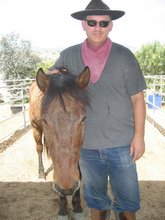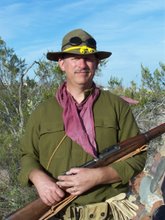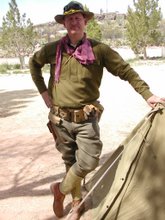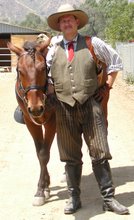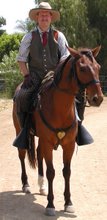Today I spent a good part of today helping clear brush and trim back vegetation along the Doc Larsen Trail with some friends from ETI Corrals 10 and 20 and a troop of Boy Scouts (I believe they were from Pasadena). Talk about exhausting work!
People often take the trails for granted and somehow assume that the trails are maintained by the Forest Service or some other governmental entity. The reality is that most trail maintenace around where I ride is done by volunteers. While in the past I've benefited from clear trails, I've done nothing in return so now was my chance- apparently the Boy Scouts approached ETI about doing a public service project and I was soon involved through my memebership in ETI.
We were divided into a number of groups who were to start work at various parts of the trial. I volunteered to start with the group furthest out, at the top of the Doc Larsen Trail and we were to work our way down to the bathtub (I've previously posted pictures of this). By the time we had gotten organized, it was about 9:30 am and beginning to warm up.
The section we were working on mostly required tree branch trimming and some work on re-setting water bars (logs set in the trail to help present erosion during rainy periods). That was some pretty tough work- the ground was like concrete and naturally we'd left the pickaxe back at base camp. Somehow I managed to scratch out a groove with a
McLeod (a heavy combination hoe & rake; the Forest Service had loaned us a number of these) and then a couple of other people set and wired in the logs.
We worked until about 12 Noon and successfully cleared our portion of the trail up to the Bathtub. We then made our way down the trail until we'd met up with the others and proceeded to the rendevous point at the Oaks. Unfortuantely, we didn't have an adequate amount of people and much of the trail between the Bathtub and the Fire Road was missed. We tried to remove the more obvious stuff but the trail is going to need some more work- perhaps in the Fall.
It was definately hot by the time we made it down to the Oaks and I have to say that I now have a real appreciation for Max- although we only had to go downhill, I have to give it to Max: he's incredibly patient and tough. To haul my 230-pound carcass on a hot day up a steep trail...I love my horse! And you sure learn to appreciate them!
We only had one problem with one of our party getting overcome by the heat but we were able to head off any problems by making sure he drank a lot of water and got him into the shade. Overall, things were successful and we did our good deed for the day. However, the next time we do this, I hope we do it when it's a lot cooler!
 Summer 1912 cotton uniform with 1912 Garrison Belt rig.
Summer 1912 cotton uniform with 1912 Garrison Belt rig.
 Summer 1912 cotton uniform with 1912 Garrison Belt rig.
Summer 1912 cotton uniform with 1912 Garrison Belt rig.






